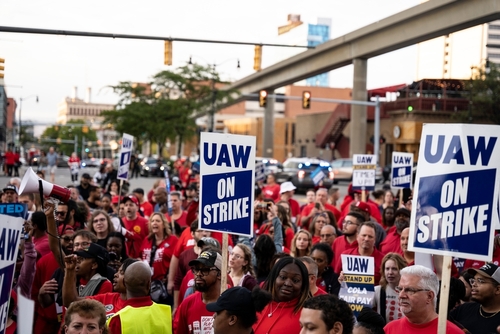After years of decline, the organized labor movement has been seeing a resurgence, with attention-grabbing headlines making waves across various industries and locales. From auto workers to Hollywood’s glitterati, the call for better working conditions, fair pay, and respect in the workplace is loud and clear.
However, this surge comes against a backdrop of declining union membership over the past few decades. Here, we take a look at the current state of organized labor and its implications for the American workforce.
United Auto Workers’ Strike
The impact of the United Auto Workers (UAW) union’s strike against Detroit automakers has been significant. As the action against all three major Detroit automakers entered its second month, the union’s president, Shawn Fain, emphasized a “new approach” to their strategy. The strike, which now encompasses multiple assembly plants and parts distribution centers, underscores the workers’ demands for better wages and working conditions.
The auto industry, a cornerstone of the American economy, has felt the ripple effects of this movement, and consumers are likely to feel similar effects.
Hollywood Actors’ and Screenwriters’ Strike
The entertainment industry hasn’t been immune to labor unrest either. With recent strikes by both Hollywood actors and screenwriters, it’s evident that even in industries known for glamor and glitz, a chasm can form between those in the top echelon and the many who work behind the scenes.
Downward Trend in Union Membership
Despite these high-profile strikes, it’s essential to note the broader context of union participation. Over the past several decades, union membership in the United States has seen a steady decline. Once a formidable force in the American labor landscape, unions have faced challenges ranging from political opposition to changing economic structures.
The shift from manufacturing to service-based industries, globalization, and anti-union legislation have all played a role in this decline.
Industries with High Union Membership
While union membership has decreased overall, certain sectors still see a higher concentration of unionized workers.
For instance, public sector workers, including teachers, firefighters, and police officers, tend to have a union membership rate of over 30%. On the other hand, the private sector, which includes industries like auto manufacturing and entertainment, has a significantly lower rate of participation.
However, as recent strikes indicate, even sectors with lower union membership aren’t immune to labor unrest.
The recent strikes and labor movements serve as a reminder of the power and importance of organized labor. While union membership may have declined, the spirit of collective bargaining and the fight for workers’ rights remains very much alive.
As the landscape of work continues to evolve, the role of unions in shaping that future will undoubtedly be a space to watch.
At the same time, employers across all industries should be continually considering the steps they’re taking to build and maintain strong relationships with their employees.
Lin Grensing-Pophal is a Contributing Editor at HR Daily Advisor.

